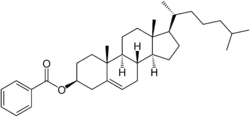Cholesteryl benzoate
Cholesteryl benzoate, also called 5-cholesten-3-yl benzoate, is an organic chemical, an ester of cholesterol and benzoic acid. It is a liquid crystal material forming cholesteric liquid crystals with helical structure.
 | |
| Identifiers | |
|---|---|
3D model (JSmol) |
|
| ChemSpider | |
| ECHA InfoCard | 100.009.150 |
PubChem CID |
|
| UNII | |
CompTox Dashboard (EPA) |
|
| |
| |
| Properties | |
| C34H50O2 | |
| Molar mass | 490.76 g/mol |
| Melting point | 149 to 150 °C (300 to 302 °F; 422 to 423 K) |
Except where otherwise noted, data are given for materials in their standard state (at 25 °C [77 °F], 100 kPa). | |
| Infobox references | |
It can be used with cholesteryl nonanoate and cholesteryl oleyl carbonate in some thermochromic liquid crystals.
It is used in some hair colors, make-ups, and some other cosmetic preparations.[1]
It can be also used as a component of the liquid crystals used for liquid crystal displays.
Cholesteryl benzoate was the first material in which liquid crystal properties were discovered. In the late 1880s Friedrich Reinitzer, an Austrian botanist, while studying the chemicals in plants, heated cholesteryl benzoate. At 145 °C the material melted, yielding a cloudy fluid, which changed to the originally expected clear liquid at 178.5 °C.[2] In 1888, the German physicist Otto Lehmann concluded the cloudy fluid presents a new phase of matter, and coined the term liquid crystal.[3]
References
- Record in the Household Products Database of NLM
- "Introduction to Liquid Crystals". CWRU Polymers and Liquid Crystals. Case Western Reserve University. Archived from the original on 5 March 2016. Retrieved 5 February 2016.
- "History and Properties of Liquid Crystals". Official Web Site of the Nobel Prize. Retrieved 5 February 2016.